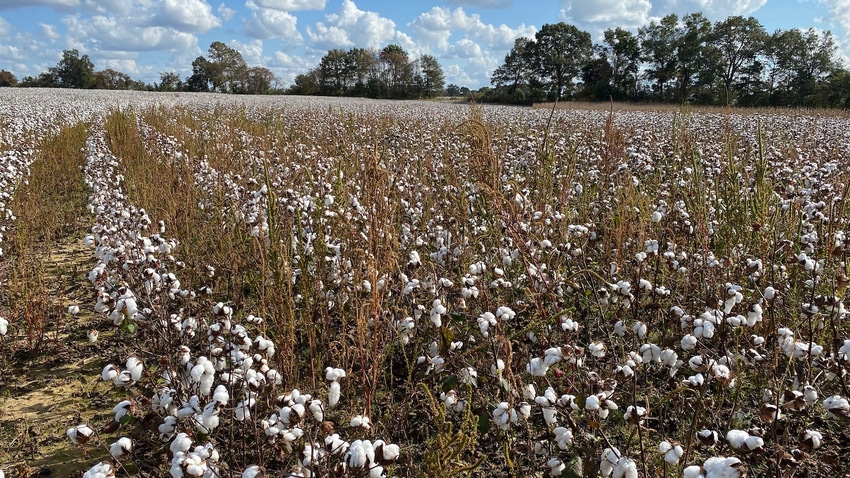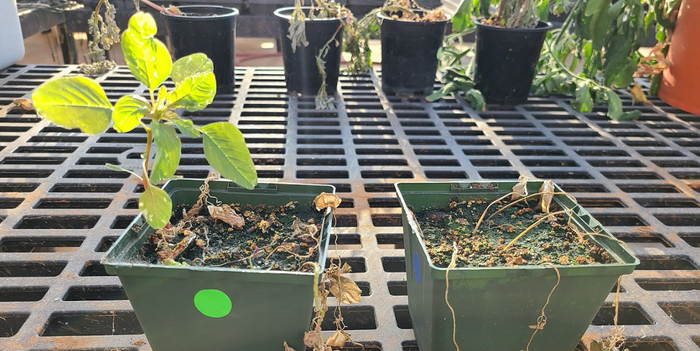
Eric Burt has been farming cotton all his life, and when it comes to crop afflictions, he’s certainly seen his share. But in his opinion, past battles with boll worms and even boll weevils do not compare to the war he is waging with Palmer amaranth.
“We’ve been fighting this a long time, and we’ve spent a lot of money, but we’re not killing the weeds,” Burt said. “That’s the problem. You can burn them, twist them, bang them around, but you’re not getting rid of them.”
Burt and his brothers farm about 2,600 acres on the outskirts of Jackson, Tenn. They grow mostly cotton, but corn and soybeans, too. Glyphosate-resistant pigweed first cropped up in his fields more than a decade ago. In the years since, he has tried many different herbicide programs – Liberty Link, Xtend, Enlist — but the pigweeds have kept coming. With subdivisions bordering many turnrows, Burt’s hands have been tied by spray restrictions, particularly with dicamba. He believes these restrictions have likely compounded his weed issues.
Burt now has pigweed populations with confirmed resistance to dicamba and possibly 2,4-D. Even pre-emergence programs do not seem to be working as well. He now grows mostly Enlist cotton and has found that two rounds of 2,4-D followed four to five days later with glufosinate is his best hope for managing Palmer amaranth, but it’s far from perfect.
“You look across the field and don’t see the pigweeds, but they’re still there competing with your crop and producing seed for next year,” Burt said. “And, of course it’s expensive. Even with better cotton prices, all these applications are eating into your profits. Hopefully, some things are coming that will help.”

Resistance research
Unfortunately, Burt is hardly the only Midsouth producer hoping for more viable herbicide options to control Palmer amaranth. Since its arrival to the region, the number of herbicide sites of action that this weed has achieved resistance to has increased dramatically. Most recently, researchers in Arkansas confirmed the discovery of Palmer amaranth populations resistant to glufosinate.
Larry Steckel, Extension weed specialist with the University of Tennessee Institute of Agriculture has been an eyewitness to herbicide breakdowns in his state. He insists that glufosinate is continuing to hold in Tennessee. However, auxin herbicide resistance is a growing concern.
“We’ve been using dicamba for 20 years for burndown. So, we’ve been exposing a lot of Palmer amaranth to a fairly low rate of dicamba for two decades,” Steckel said. “By doing that we’ve selected for tolerance early on, unlike areas where no-till is not as prominent.” Roughly 80% of Tennessee’s row crop acres are planted using no-till, according to the USDA National Agricultural Statistics service.
In 2019, with complaints about dicamba control growing, Steckel collected seed samples from five locations across the state to be evaluated for resistance in a laboratory greenhouse. One of those locations was Burt’s farm.
“I told him if you’re looking for a place to test pigweeds, we’ve got plenty,” Burt said.
The cooperation of producers like Burt is helping researchers learn more about weed resistance. The findings in the greenhouse study suggest metabolic resistance is present in Tennessee Palmer amaranth populations. This is the first time metabolic resistance has been documented in Tennessee, and while the results do not bode well for near term weed control, they can help scientists find answers for the future.
Metabolic weed resistance
For those of us without a chemistry degree, metabolic resistance is a complex concept to grasp. Although to be fair, even the experts admit there is much to be learned on the subject. What they do know is that metabolic resistance could make weed control even more challenging in the future.

Cytochrome P450 is a naturally occurring enzyme that detoxifies foreign chemicals. It’s found in plants and animals, but plants have more genes for the P450 enzyme. Over time growers inadvertently select for weeds with higher numbers of these enzymes in their genetic makeup. Weeds with these enzymes display a broader, lower-level resistance across several herbicides.
“What we’re learning is metabolic resistance for one herbicide can affect other herbicides, too,” Steckel said. “For example, in other states metabolic resistance to 2,4-D was also hurting the performance of Group 15 herbicides on Palmer amaranth control. It makes weed management much less predictable.”
Burt says he too has seen issues with Group 15 herbicides like Dual in his pre-emergence program. Whether that is due to metabolic resistance or other factors has not been confirmed.
Insecticides resurrecting herbicides?
Researchers test for metabolic resistance by mixing the herbicide in question with malathion. Malathion, along with all the organophosphate insecticides, are known cytochrome P450 inhibitors. That means they will bind up the enzyme that is detoxifying the herbicide. If adding malathion to the herbicide improves weed control, you can assume you are dealing with a metabolic-resistant weed.
This is what Steckel and PhD student Delaney Foster saw when testing those Tennessee Palmer amaranth populations in the greenhouse. Adding malathion to dicamba increased control by 6 - 23% at the 1X rate. Meanwhile, in 2,4-D greenhouse screenings, the addition of malathion increased control by 12 – 32% at the 1X rate.
“The idea is the insecticide is competing for that cytochrome P450, so there’s a lot less of it available to detoxify the herbicide,” Steckel said.
Researchers with Kansas State University performed similar tests with similar results. Their study was published in a recent issue of Frontiers in Plant Science. And malathion-induced reversal of weed-resistance to 2,4-D, fomesafen and mesotrione has been documented by scientists.

While the findings of metabolic resistance are troubling, these studies suggest a possibility of mitigating herbicide resistance by adding an OP insecticide to the tank. Steckel said it has been done in Australia.
“I’m certainly not recommending this yet because our research has been limited to the greenhouse, and just because it works in the greenhouse doesn’t mean it will work in the field,” Steckel said. “But we’re going to do a lot of field trials this year, and I think we’ll find out a lot.”
In his field trials, Steckel also to plans to evaluate the effect of another organophosphate insecticide, Orthene. One of the locations for Steckel’s field trials is Eric Burt’s farm.
“I’m excited to see if that works in the real world,” Burt said. “I’m hopeful it will.”
In the meantime, Steckel advises producers to strive for clean fields in 2021 by relying on a good pre-emergence program.
“Starting clean is important. Pre’s are more important than ever because we’ve got to get the numbers down,” Steckel said. “You’ll have escapes, but any escapes from dicamba and 2,4-D you have you need to get back on them with glufosinate as soon as you can. Going back over fields 20 – 30 days later is not quick enough.”
About the Author(s)
You May Also Like






